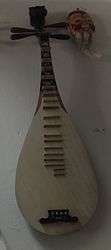Đàn tỳ bà
 | |
| Classification | |
|---|---|
| Related instruments | |
The đàn tỳ bà (Vietnamese: [ɗâːn tî ɓâː], Chữ Nôm: 彈琵琶) is a Vietnamese traditional plucked string instrument related to the Chinese pipa.[1]
It is made of wood, with a distinctive pear shape and four strings made of nylon (formerly twisted silk). The instrument is held in a near-vertical position when playing and its playing technique involves frequent bending of the tones with the fingers of the left hand. The strings are plucked with a small plectrum similar to a guitar's but larger. It was associated with the royal court and is still used in the ensemble that performs at the Imperial Palace at Huế.
The instrument's name is a Vietnamization of the name of the Chinese pear-shaped lute, called pipa, from which the đàn tỳ bà is derived. "Đàn" is the Vietnamese prefix meaning "stringed instruments", which is part of the name of most traditional stringed instruments of the Viet majority.
The Tỳ bà hành (Hán tự: 琵琶行) is a well known piece for ca tru ensemble.[2]
See also
References
- ↑ Garland Encyclopedia of World Music South East Asia p262 "The tỳ bà, a pear-shaped lute, first appeared in Vietnam in the early 600s"
- ↑ Songs for the Spirits: Music and Mediums in Modern Vietnam p150 Barley Norton - 2009 "These include the ca tru pieces “Ty Ba Hanh” and “Bac Phan,” which became part of the “Phu” group of songs and were .. "